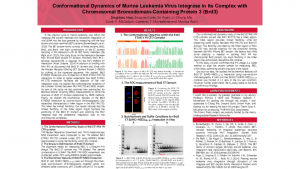Hao, Jingzhou: Conformational Dynamics of Murine Leukemia Virus Integrase in its Complex with Chromosomal Bromodomain-Containing Protein 3 (Brd3)
Title: Conformational Dynamics of Murine Leukemia Virus Integrase in its Complex with
Chromosomal Bromodomain-Containing Protein 3 (Brd3)
Name: Jingzhou Hao
Major: Biological science
School affiliation: School of Arts and Sciences
Programs: Aresty – Research or Conference Funding Recipient
Other contributors: Gaetano T. Montelione and Monica Roth, Swapna Gurla, Sri Aiyer, Li-Chung Ma, Scott A. McCallum
Abstract: Murine Leukemia Virus (MLV) is a gammaretrovirus which can integrate its viral cDNA into the host genome, catalyzed by the viral integrase (IN). The MLV IN requires the nuclear envelope to disassemble to gain access to host DNA during mitosis. During this process the IN protein interacts with the host Chromosomal Bromodomain-Containing Protein 3 (Brd3 protein), which influences the site of viral integration. Previous studies have found that MLV IN binds with the ET domain of Brd3 protein through its C terminal domain (CTD). This interaction helps MLV IN integrate into actively transcribed regions of the chromosome. In order to better understand how MLV IN CTD facilitates integration site selection when interacting with the Brd3 ET domain, we studied the conformational dynamics of the complex formed between MLV IN CTD and Brd3 protein. As part of this study we also explored new approaches for Residual Dipolar Coupling (RDC) measurements, to further refine the accuracy of the Brd3 ET protein structure determined by NMR methods. Finally, we studied the interaction between Brd3 ET and Human Nuclear Receptor Binding SET Domain Protein 3 (NSD3) to compare the structure of this complex and the one formed between Brd3 ET and MLV IN. In studying the structure of the Brd3 ET-MLV IN CTD complex, we characterized a 10-residues linker region in the MLV IN CTD. This linker has limited flexibility. Our results indicate that the limited flexibility of the linker region might facilitate the anchoring of the Brd3 ET domain and orienting the MLV integrase near the preferential integration sites on the chromosomal complexes. Our study provides novel information about the mechanism of MLV gene integration, revealing for the first time a potential role for the unstructured linker region in the biological process. More importantly, our findings provide fundamental structural biology data that will inform the design of small molecule inhibitors to regulate the MLV integration and for developing the MLV-based vector for gene therapy.
